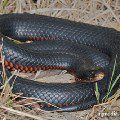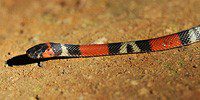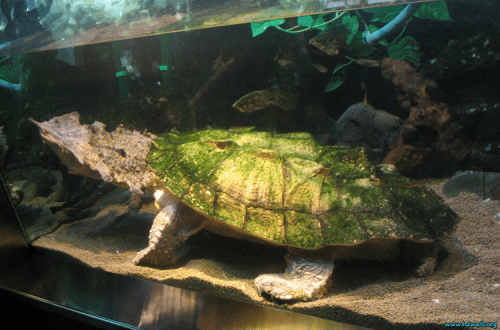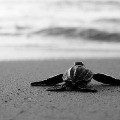
Leatherback turtle
The leatherback turtle is the largest living turtle. In length, it can reach 2 meters, and the weight can approach a ton. It is found in the territories of practical seas. In Russian waters, it was found in the Bering Sea and in the Far East. These turtles are inherently loners, very shy and do not gather in herds, therefore, despite their impressive size, they are quite difficult to spot.
From other species, the leatherback turtle is cast by the structure of the shell, which is covered not with horny plates, but with thick skin. Her shell is heart-shaped, has five longitudinal ridges on the ventral side and seven ridges on the dorsal side. The limbs of the turtle are in the form of flippers, which reach a transverse span of three meters. There are no claws on the flippers. In the water, the turtle is very mobile and develops great speed. It dives well and can go to a depth of 600 meters. Omnivorous, feeds on both algae and fish, jellyfish, crustaceans.
Oviparous. Digging with its hind flippers, it digs a hole about a meter deep and lays 30-130 white spherical eggs with a leathery shell in it, tightly compacting the sand after laying.
Lives in nature for at least 23 years. It is on the verge of extinction and is listed in the International Red Book.
Other names
Dermochelys coriacea.
Types
Dermochelys coriacea coriacea
Dermochelys coriacea schlegeli
Inhabitation
This species is widespread in the territories of all tropical seas, although it can sometimes swim in temperate waters, and even in the waters of northern latitudes.
Spends almost all the time in the water, leaving the land only during the breeding season.
The main range extends from Nova Scotia to Argentina. It can also often be found in the Pacific Ocean in waters from Japan to South Australia, from Chile to British Columbia. In the tropical regions of the Indian Ocean, she is also a frequent visitor. Occurred twice in Russian waters – in the Bering Sea and in the south of the Far East.
The fact that most of all leatherback turtles are found near the South Kuril Islands is most likely due to the fact that a branch of the warm Soya current passes in this area.
These tortoises are solitary in nature and extremely difficult to spot as they do not gather in herds. They are very shy and cautious.
Description
 At the moment it is the largest of modern turtles. The length of her body reaches 2 meters, she can weigh up to 900 kg.
At the moment it is the largest of modern turtles. The length of her body reaches 2 meters, she can weigh up to 900 kg.
The leatherback turtle differs from other species most of all in the special structure of its shell, which is covered with thick skin, and not, as usual, with horny plates. The dorsal shield consists of small bony plates, which can be counted in the hundreds, and they are not connected to the ribs and spine. The carapace is heart-shaped, strongly narrowed behind and has 5 longitudinal sharp ridges on the ventral side and 7 ridges on the dorsal side. The skin covering on the back of turtles does not have the armor-like features that most turtles have. At the same time, the shell is present in the form of bones that have grown together with the skin on the back of the turtle. The unique shell structure of the leatherback turtle (pseudocarapace) favorably facilitates its movement through the water space, and at the same time serves as an excellent means of protection.
The limbs of a leatherback turtle are in the form of flippers, which in a transverse span reach 3 meters. There are no claws on the flippers. The front legs are longer than the hind legs and are the main driving force, while the hind limbs mainly perform the function of the steering wheel. Despite the fact that the turtle shell is not connected to its skeleton, it is impossible to “remove” it. Due to the large size of the head, she cannot even hide her head in the shell. On the upper jaw, she has one sharp and large tooth on each side. There are three triangular notches on the horny margin of the upper jaw. Males differ from females in a longer tail and, less commonly, a shell narrowed behind.
In adults, the carapace is covered with skin, the carapace is black-brown or dark brown, the edges of the flippers and longitudinal ridges are yellow. In newborn turtles, the carapace is covered with a layer of plates, which disappear after a few weeks. In juveniles, the body is covered with yellow markings.
The subspecies coriacea coriacea is distinguished by longer limbs in relation to the body, a dark head with several spots on the back, lower jaw and throat.
The subspecies Coriacea schlegeli has shorter limbs. The head is light in color, long, with a large number of spots on the throat, back and lower jaw.
In water, the leatherback turtle is very mobile, develops great speed and maneuverability. In cases of danger, it fiercely defends itself, using sharp jaws and striking with powerful flippers. Adults have tremendous physical strength. When threatened, it violently fights back with its powerful front flippers. Moreover, her jaws, which are covered with a massive horny layer, coupled with teeth and jagged edges, are a dangerous weapon. With them, the turtle can easily bite sticks a few centimeters thick. When injured, she lets out a loud cry.
In nature, leatherback turtles live for at least 23 years.
Food
The main diet of the turtle is crustaceans, fish, mollusks, jellyfish and algae. In general, the leatherback turtle is an omnivore, eating any available food without much preference. With its jaws, the turtle deftly captures such slippery food as, for example, jellyfish.
Reproduction
The oviposition period occurs from May to August. The main nesting sites of the leatherback turtle are in Ceylon, where the turtle lays from May to June, and on the shores of the Caribbean Sea, laying takes place from May to August.
Creeping ashore after sunset, she looks for a place above the high tide line to create a nest. With its hind legs, it digs a deep hole, up to a meter deep, and lays in it from 30 to 130 spherical eggs with a white leathery shell and 5-6 cm in diameter. for predators.
The leatherback turtle lays eggs once every 2-3 years. During the season, the turtle can lay 6-9 nests. The incubation period is about 2 months.
Unfortunately, scientists have only been able to find leatherback turtle egg-layings a few times. As for the process itself, only a few were lucky enough to see it.
An interesting fact is that about a third of the eggs in the clutch are not fertilized.
Scientists who observed the laying of the turtle noted one feature. On top of the masonry lay several small balls that did not contain yolk. There was only one protein in the shell. It seemed that the turtle had extra protein left, and she made some useless, yolkless eggs for her offspring, instead of throwing it away, and put these balls next to the rest.
Additionally
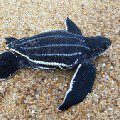 The leatherback turtle has a rather formidable weapon – a beak with cutting edges. There were cases when she used it against a shark attacking her.
The leatherback turtle has a rather formidable weapon – a beak with cutting edges. There were cases when she used it against a shark attacking her.
The skin and shell of leatherback turtles are saturated with fat, which is rendered and used for lubricating boat seams and other purposes. This property brings a lot of inconvenience in museum storage, since fat can be released for years, unless the shell has been specially processed before.
Meat can be eaten. Both the turtles themselves and their eggs for the population of Trinidad, Mexico, Guinea have long been considered an important part of the food chain, so in many areas the number of leatherback turtles has drastically decreased, and in some this species of turtles has disappeared completely. To restore the population, many states have declared coastal zones as national reserves. Scientists in some areas are trying to restore the population with the help of incubators. This species of turtle is listed in the International Red Book.
There are not fully confirmed data that leatherback turtle meat contains a substance toxic to humans and other animals – chelonitoxin, but its chemical composition has not been determined. Possible symptoms of poisoning are vomiting, diarrhea, heaviness in the chest, nausea, burning in the mouth, excessive salivation, shortness of breath, skin rash, bad breath, coma, death. However, this information, obtained in the 80s of the 20th century, does not agree with the data on the active use of leatherback turtle meat for food.
Scientists have found that leatherback turtles make rare dives to considerable depths to conduct reconnaissance of food supplies. For the study, 13 individuals were caught, each of which had a special device attached to the shells, which recorded the depth and duration of the dive, as well as the temperature of the water. In those moments when the turtle rose to the surface, the collected information was transmitted to the satellite.
As a result of these studies, the following data was obtained: out of 26 thousand dives, 95 of them were made to a depth of more than 300 meters. Before these studies, there were several hypotheses explaining such deep dives: to escape from predators, to cool down, in order to get more tasty food.
However, the collected data disproved these hypotheses. Leatherback turtles can dive to depths of up to 600 meters. At the same time, starting from a depth of 350 meters, the water temperature does not change significantly, and therefore, there is no need for cooling at such a depth. Regarding protection from predators, certain doubts also arise, since when diving, the turtle does not greatly increase its speed of movement. The third hypothesis is considered the most reliable, since the leatherback turtle feeds on jellyfish, which at night descend to great depths, uniting into large colonies. Turtles keep track of their locations so that when jellyfish appear in shallower water layers, they can eat them.
Sources of
http://www.floranimal.ru
http://slovari.yandex.ru
http://www.ecosystema.ru
http://www.cherepahi.ru
http://lenta.ru



